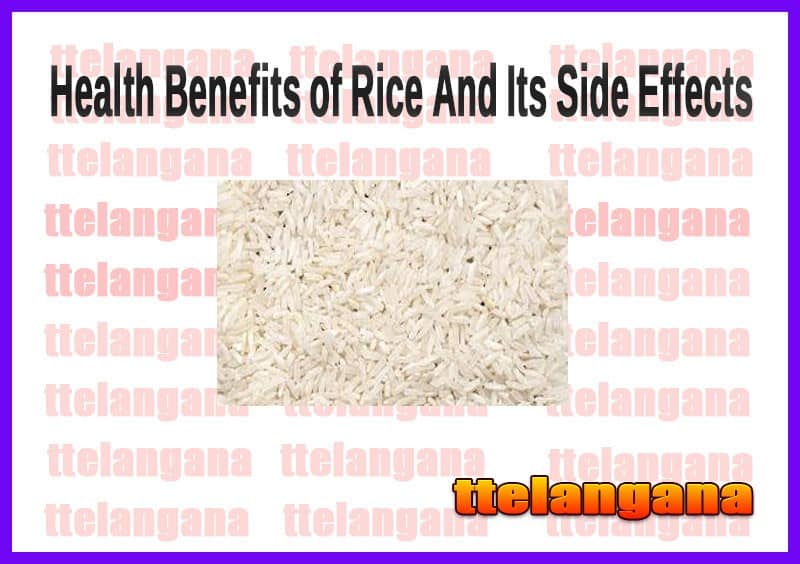Health Benefits of Rice And Its Side Effects
Rice is one of the most widely consumed staple foods around the world and has been a dietary staple for centuries. It is a versatile grain that provides numerous health benefits and serves as a valuable source of nutrition for many populations. However, like any food, rice can have both positive and negative effects on health.
Nutritional value of 100 grams of Rice:
The nutritional value of 100 grams of cooked white rice amounts to approximately 130 calories. This serving size contains 69% water, 2.4 grams of protein, 28.7 grams of carbohydrates, 0.2 grams of total fat, including 0.05 grams of saturated fat and 0.06 grams of polyunsaturated fat (including 0.03 grams of omega-3 and 0.04 grams of omega-6), with no trans fats. It does not contain any sugar or dietary fiber.
The nutritional facts for 100 grams of rice are as follows:
Calories: 130
Total fat: 0.3 grams
Sodium: 1 milligram
Potassium: 35 milligrams
Total carbohydrate: 28 grams
Protein: 2.7 grams
Rice also provides various vitamins and minerals in smaller amounts, including:
Calcium: 0.01%
Iron: 1%
Vitamin B-6: 5%
Magnesium: 3%
Health Benefits of Rice And Its Side Effects
Health Benefits of Rice:
Energy Source: Rice is an excellent source of carbohydrates, which are the primary source of energy for the body. It provides a steady release of energy due to its complex carbohydrate content, making it an ideal choice for sustained physical activity and maintaining energy levels throughout the day.
Nutrient-Rich: Rice contains essential nutrients such as vitamins, minerals, and dietary fiber. It is a good source of B vitamins, including thiamin, niacin, and riboflavin. These vitamins play crucial roles in energy production, metabolism, and maintaining healthy skin and nerves. Additionally, rice contains minerals such as iron, magnesium, and selenium, which are important for various bodily functions.
Digestive Health: The fiber content in rice aids in maintaining a healthy digestive system. Dietary fiber adds bulk to the stool, promoting regular bowel movements and preventing constipation. Consuming fiber-rich rice varieties, such as brown rice or wild rice, can contribute to improved gut health.
Heart Health: Whole grain varieties of rice, such as brown rice, contain higher levels of dietary fiber and beneficial compounds compared to refined rice. These compounds, including antioxidants and phytochemicals, have been associated with a reduced risk of heart disease. Additionally, brown rice is lower in cholesterol and saturated fats compared to white rice, making it a heart-healthy choice.
Weight Management: Rice, particularly whole grain varieties, can be beneficial for weight management. The high fiber content provides a feeling of fullness, reducing hunger and preventing overeating. Additionally, the low-fat content in rice makes it a suitable option for those aiming to maintain or lose weight.
Gluten-Free: Rice is naturally gluten-free, making it a safe and nutritious alternative for individuals with celiac disease or gluten sensitivity. It can serve as a staple grain for those following a gluten-free diet.
Side Effects of Rice:
Arsenic Contamination: Rice has been found to contain small amounts of arsenic, a naturally occurring element that can be harmful to human health. Arsenic can accumulate in rice through various factors, including the soil it is grown in and water used for irrigation. Long-term consumption of rice with high levels of arsenic may increase the risk of certain health conditions, such as cancer and cardiovascular disease. To minimize exposure, it is recommended to vary the types of grains consumed and choose rice varieties with lower arsenic levels.
Glycemic Index: White rice has a higher glycemic index compared to whole grain varieties. This means it can cause a rapid rise in blood sugar levels, which may not be ideal for individuals with diabetes or those trying to manage their blood sugar. Choosing whole-grain rice options or pairing rice with fiber-rich foods can help mitigate the glycemic impact.
Potential for Weight Gain: While rice can be beneficial for weight management, excessive consumption of calorie-dense rice dishes or refined rice can contribute to weight gain. Portion control and choosing whole grain rice varieties can help maintain a balanced diet and prevent excessive calorie intake.
Lack of Nutritional Diversity: Relying solely on rice as a primary food source can result in a lack of nutritional diversity. Rice lacks certain essential nutrients, such as complete proteins and certain vitamins. It is important to incorporate a variety of other foods, including fruits, vegetables, lean proteins, and legumes, to ensure a well-rounded and balanced diet.
Digestive Issues (in some individuals): While rice is generally well-tolerated, some individuals may experience digestive issues, such as bloating or gas, after consuming rice. This can be due to various factors, including the type of rice consumed, individual digestive sensitivity, or methods of preparation. Experimenting with different rice varieties or preparation techniques can help alleviate such issues.
It is worth noting that the health benefits and potential side effects of rice can vary depending on the type of rice consumed, processing methods, and individual health factors. It is always advisable to consult with a healthcare professional or registered dietitian for personalized dietary advice and recommendations based on specific health needs.
Tags: health benefits of black rice, black rice health benefits, health benefits of brown rice, health, benefits of brown rice for health, incredible health benefits of black rice, benefits of brown rice, health benefits, health tips, benefits of black rice, brown rice health benefits, health benefits of rice, health benefits of fermented rice, health benefits of red rice, health benefits of wild rice, health benefits of oats, health benefits of garlic
